Notice: Undefined variable: page in /home/vrxdg1855sn3/public_html/wp-content/themes/72tree/content.php on line 15
Notice: Trying to get property 'ID' of non-object in /home/vrxdg1855sn3/public_html/wp-content/themes/72tree/content.php on line 15
My Neighbor’s Tree Fell on My House, Now What?
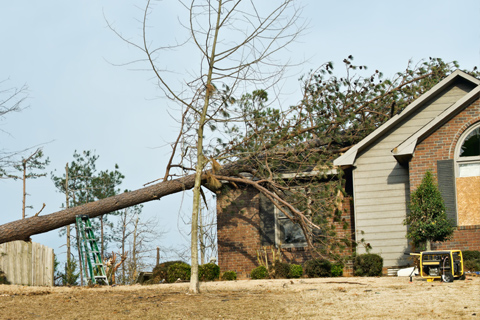
When your neighbor’s 100-foot tree crashes down onto your house, there is much to be done to get life and your home back to normal. When the adrenaline and nerves settle, you’ll need to know what to do next to quickly and safely resolve the situation.
Within greater Atlanta, trees fall pretty frequently. When one lands on a house, immediate action must be taken to prevent further damage and determine who is responsible.
Neighbor’s trees that have fallen on homes is something 72 Tree service has had more than 45 years of experience in mitigating, and in this article lay out exactly the steps and factors you should consider.
What To Do When Your Neighbor’s Tree Falls on Your House
Similar to a fire or flood, it should be treated as an emergency when a tree crashes down on your home. Fast action is required, and the following steps will help you keep everyone safe while getting your home and life back to normal:
1 – Evacuate the property! Get everyone (including pets) out of the house. Gas, water lines, and electrical systems can be severely damaged creating a fire, explosion, or electrocution hazard.
If the tree damaged any vital home systems, and it is not safe to return to the home, get your loved ones to a safe location until after the repairs.
2 – Call 9-1-1 or Respective Emergency Services, to report the incident if your neighbor’s tree:
• Inflicted any injuries or caused any fatalities
• Crossed power lines or damaged utilities before falling on your home, or
• Threatens pedestrians or is blocking the flow of traffic
In such cases, an emergency dispatcher is able to mobilize Medical Services, utilities, a power company unit, or other necessary departments to ensure your and the public’s safety.
Visit 72tree.com/power-line-interfering-trees-city-alpharetta-ga-ordinance/ for non-emergent interfering power lines.
3 – Turn the power off immediately if you smell gas, or water is coming through the roof or from broken pipes. Next locate and turn off the gas and/or water main.
This is a dangerous situation because a spark can cause an explosion from a gas leak, or you could be electrocuted if water comes in contact with live electrical wires.
4 – Document everything that is taking place! Take pictures of the tree and all related damages. This will help you in supporting your case and recovering your settlement when filing an insurance claim.
5 – Contact your homeowner’s insurance provider to report the situation, and follow their instructions (not doing so will potentially void your policy).
6 – Contract a 24-hour emergency tree removal company and certified arborist to remove the tree, and assess whether or not the tree was diseased, dead or dying before it fell.
Depending on the location of the fallen tree and degree of difficulty in accessing it, be sure to contract a tree service that has the skills, experience, tools and equipment (bucket truck, crane, etc.) to get the job done efficiently and safely.
Watch this Roswell removal team to see the correct process of using a crane to remove a fallen tree.
7 – Contract a 24-hour roofing company to inspect damages, tarp, and repair or replace your roof.
8 – Contract a 24-hour plumber if you have any visible leaks or broken pipes that must be repaired. Otherwise, during regular hours contact a plumber to examine your home’s plumbing system for any unseen or concerning collateral damage.
This is an essential step. The jolt of a tree crashing into your home has the potential to disturb and damage the plumbing throughout, and even on the opposite side of the house.
9 – Contract a 24-hour emergency water removal company if water is flooding your home from a storm or broken pipe(s). It is a top priority to cleanup and extract any water from causing further structural damage, or causing a future issue with mold.
What You Need To Know If Your Neighbor’s Tree Falls on Your House
Your House – When your neighbor’s tree falls on your house, there will be apparent damages to the landing area. This type of impact will typically result in hidden structural, electrical, and plumbing problems throughout the house.
Your Neighbor’s Tree – The state of the tree before it fell is of the utmost importance, and the following scenarios will illustrate why:
Scenario #1 (Your Liability) – If your neighbor’s tree was healthy and thriving when it was uprooted, broken, or blown over by severe weather, it is your own homeowner’s insurance policy that will cover damages to your home.
Scenario #2 (Their Liability) – If it is determined and documented by a certified arborist that your neighbor’s tree was diseased, dying, or dead when the event occurred, your neighbor may be held fully responsible for all damages when the following conditions are true:
• In the State of Georgia, the tree owner can be held liable for damages and injuries resulting from the tree’s falling, only if he or she had preexisting knowledge of the tree being dead, dying, or diseased. If there were no apparent reasons for concern (no visible signs of trouble) or no documentation stating otherwise, the tree owner (your neighbor) could not be considered at fault.
• When it can be proven in written form that an arborist, neighbor, tenant, city employee, or other third party identified and reported to the neighbor the existence of a problem before the tree fell, this constitutes preexisting knowledge on the part of the tree owner.
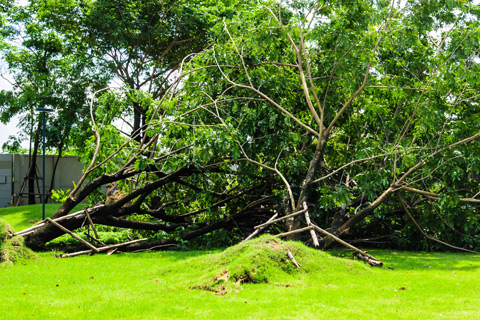
Adjacent Trees – When a tree is uprooted during a storm, be cautious of the trees close to it. Trees growing close together will often rely on each other’s roots to anchor themselves, and when one of those trees falls, the trees around it may become destabilized and fall as well.
The Insurance Company – Some insurance policies can be complicated and confusing, but if the tree damaged a structure on your property – once you have met your deductible and have not exhausted the total coverage limits of your policy – your insurance provider may be liable to pay for damages up to your coverage limits.
The emergency removal company you contract should specialize in large loss claims, and support your efforts in working with your insurance company. 72 Tree has successfully mitigated insurance claims for over 45 years, working with most platinum insurance companies and insurance adjusters to quickly return your life and home to normal.
Your Home, Emergency Tree Removal, Insurance, and Repairs
Knowing what to do when your neighbor’s tree falls on your home will help you focus on what needs to get done vs. who is to blame. Being able to mobilize the right services quickly will help keep stress levels under control, and allow you to get on track to returning life to normal.
Once your neighbor’s tree (or any tree for that matter) falls on your home, fast action is essential. Move your loved ones to a safe location, call 9-1-1 if needed, and contact your homeowner’s insurance provider. Then, contract a trusted emergency tree removal company, a roofing company with a contractor that can inspect the home’s entire physical structure for collateral damages, and a plumber to look for and repair any pipe ruptures or hidden leaks from the impact.
When your neighbor’s tree falls on your home, protect yourself and your assets by taking swift action. Delays or procrastination can become costly problems, potentially voiding your homeowner’s insurance policy while exacerbating damages to your home and property.
Sources:
https://secure.caes.uga.edu/extension/publications/files/pdf/C%201099_1.PDF
Notice: Undefined variable: page in /home/vrxdg1855sn3/public_html/wp-content/themes/72tree/content.php on line 15
Notice: Trying to get property 'ID' of non-object in /home/vrxdg1855sn3/public_html/wp-content/themes/72tree/content.php on line 15
9 Common Tree Health Problems and Solutions
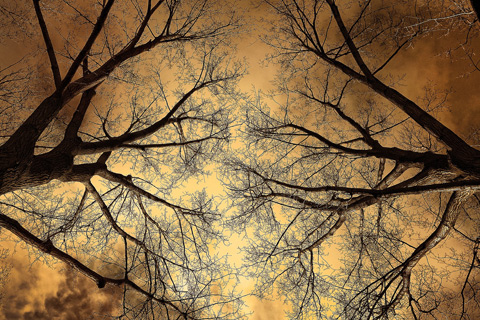
Trees get sick. Like any other living organism, a tree can fall ill for various reasons. If left to its own devices, it can eventually fall causing catastrophic damages.
When an otherwise healthy tree shows signs of illness or infestation, you must take action by eliminating the cause or calling on a certified arborist to evaluate the tree and offer a course of action.
The team of arborists at 72tree.com prepared a comprehensive list of 9 common tree health problems and their solutions.
Weather and Tree Health
Trees are affected by inconsistent weather patterns. The following demonstrates how weather impacts trees and how you can help them remain healthy.
1 – Drought:
One of the most common ailments of trees, symptoms of drought can be tricky. Sometimes, the signs won’t appear until as much as a year after the damage has been done. Those symptoms include:
•Drooping, wilting, and yellowing of leaves.
•Premature needle or leaf drop.
•Pronounced dieback.
•Thinning of the canopy.
•Deep cracks in the bark.
•Necrosis of leaves or browning of needles.
•Death of the tree.
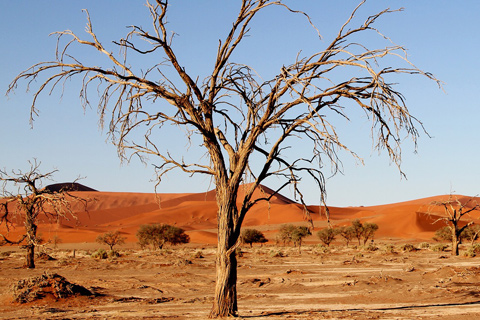
Solution 1 – For planting new trees, make sure they are appropriate for the USDA Hardiness Zone in which you are located. If your area experiences occasional or frequent droughts, seek drought-resistant species.
Solution 2 – Water your trees regularly. New trees will require a deep watering once a week for the first two years (to establish its roots). In addition to watering, add a 3-inch layer of organic mulch around the tree to help the soil retain its moisture.
After two years and through its adult life, trees are very capable of finding water sources. However, throughout dry summer months and near the end of fall, weekly deep watering and mulching will help prevent drought problems.
Solution 3 – Prune back all cracked, dead or weakened tissue. Without pruning these troubled areas, the tree will become vulnerable to infection and infestation. Call on an arborist when pruning removes more than 25% of the tree’s canopy or mass. They can assess the tree and offer a course of action.
2 – Winter Burn:
Also known as desiccation, winter burn occurs primarily in evergreens and causes a discoloration of the foliage. Effects of winter burn are more pronounced where the tree is exposed to the sun and wind. This affliction requires the presence of the following three factors:
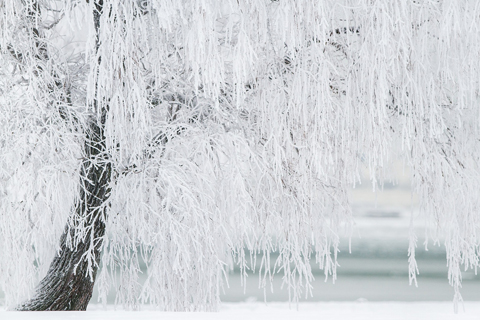
•Freezing temperatures
•Dry soil
•Wind
Solution – Provide your trees with weekly deep waterings through the end of fall and beginning of winter (before the ground freezes) and mulch the area of the root zone for the soil to retain moisture.
For trees that are highly exposed to the wind and sun, wrapping them with burlap will provide an effective barrier which can be removed as temperatures rise.
3 – Improper Pruning, Trimming, and Cutting:
There is a right way, and a right time to perform tree pruning, cutting, or trimming. When performed improperly, the tree may be left exposed to infection and infestation. When done at the wrong time, new growth may not have enough time to adapt before winter, further stressing the tree.
Solution – Know when to prune. Depending on the species of your tree, it may be better to prune in early spring, late fall, or even in the summer months. Use proper pruning or cutting methods when removing limbs, branches, or stems.
Watch this video to learn more about proper pruning techniques.
Tree Insect Infestation
For the most part, healthy trees can stave off insect infestations. However, when a tree’s health is weakened, or there is an increase in the insect population, no tree is off limits.
4 – Insects on Leaves and Bark:
Insects such as aphids, inchworms, bagworms, spider mites, lace bugs, and tree scale are common and relatively easy to manage.
Solution – Apply insecticidal soap, neem oil, or a horticultural oil directly on the area of the infestation.
5 – Boring Insects:
Insects such as the Emerald Ash Borer, Japanese Beetle, Southern Pine Beetle, and Ambrosia Beetle are more complicated to control. You can identify boring insect activity by seeing “sawdust” from their boring activity and the entry hole they create when entering the tree.
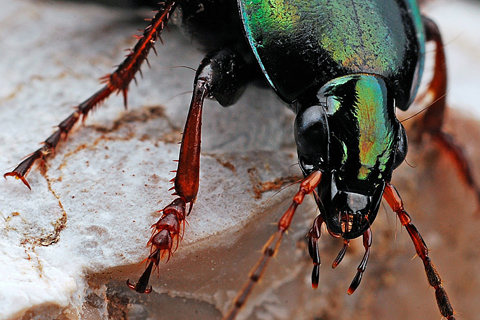
Note: Do not inject insecticides, poisons, or other substances into boring insect entry holes. The chemical may end up further damaging the tree leaving it more susceptible to infestation and death.
Solution 1 – Prune back branches and stems that have been infested and destroy them to prevent further spreading. If more than 25% of the tree’s foliage or mass must be removed, seek the assistance of a certified arborist.
Solution 2 – When the infestation is in the trunk of the tree, call an arborist to evaluate the damage and determine a safe approach to halting the infestation.
Solution 3 – Prevent infestations by keeping your trees healthy. When you hear about an outbreak in your area, treat your trees with a bark insecticidal spray to deter the insects from making your tree its host.
Tree Fungal Diseases
Most fungal diseases make their way into a tree through the roots and open wounds. Once a tree is widely infected, it becomes challenging to control the fungi and will often result in the removal of the tree.
6 – Fungal Infection (internal)
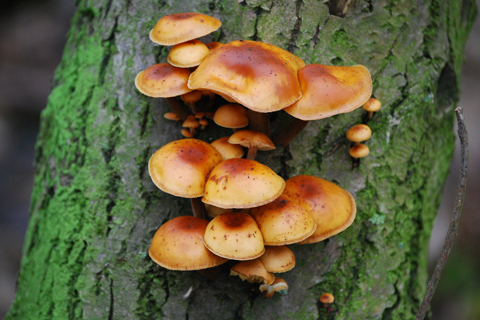
The most alarming sign of fungal trouble is when mushrooms grow on the trunk or branches. Since they require decaying matter to develop, there is a serious issue at play.
Note: The introduction of herbicides to a wounded tree or beneath the bark will only serve to accelerate the death of the tree.
Solution 1 – Prune back and destroy affected foliage, limbs, and branches. Again, when more than 25% of the tree’s foliage or mass must be removed, seek the assistance of a certified arborist. The removal of the tree may be the only way to keep your other trees from being infected.
Solution 2 – Properly prune your healthy trees (or have them pruned) to keep them healthy. A poorly pruned tree is more susceptible to both insect infestation and fungal disease.
7 – Fungal Infection (external)
The wind, birds or insects often carry spores of fungi and pathogens from tree to tree. Cankers, fire blight, rust disease, powdery mildew, and many others are common in the spring and summertime.
Solution – Carefully prune back and destroy affected foliage and apply a fungicidal spray to the affected and surrounding areas. Surrounding trees and shrubs should all undergo treatment as well.
Watch this video to learn about pathogens such as fire blight and cankers which affect tree bark and foliage.
Tree Problems Caused by People and Machinery
All of the threats mentioned above aside, people pose the most significant threat to a tree’s livelihood either by lack of knowledge or accident.
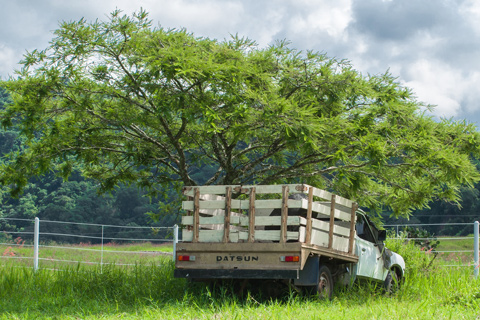
8 – Soil Compaction:
The land that surrounds a tree (especially under its canopy) contains the majority of the roots that draw water for the tree. These roots grow within the top 12 to 18 inches of soil. When this area is compacted, these roots suffocate and die, severely weakening the tree.
Trees compromised by soil compaction are at a heightened risk of toppling in a storm or severe weather event, as their roots are no longer effectively able to anchor them to the ground. Many times, no storm is required, the tree will eventually succumb to its own weight and fall on its own.
Solution – Never drive or park any vehicles underneath a tree’s canopy. Likewise, never store heavy equipment, or erect tool sheds under a tree.
In most municipalities nationwide, tree protection ordinances mandate that protective barriers be placed around trees on construction sites to deter such activities.
The majority of those same ordinances impose heavy fines and replanting requirements known as a recompense for damaged or removed trees.
9 – Lawn Mowers, Motorized Equipment, and Bark Damage:
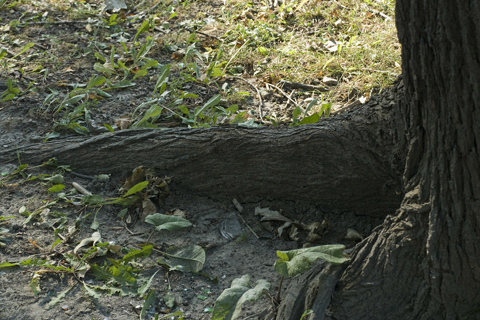
Below the bark of a tree and outer layer of roots, there is a thin layer of cells called the “phloem” which is the conduit for nutrients traveling up and down the tree.
When a tree’s bark is damaged, not only is the tree susceptible to infection and infestation, that flow of nutrients is interrupted and if the damage is around the majority or entirety of the trunk, the tree will be girdled and die.
Solution 1 – Do not allow lawn mowers and other equipment to damage protruding roots or the bark of the tree.
Solution 2 – For protruding roots, either raise the ground level to bury them, or carefully prune them. If you choose to prune the roots, call on a tree professional for detailed instruction or to do the job. Just cutting them out may result in the decline of the tree’s health and its death.
Solution 3 – If the bark of a tree is dried, cracked, or knocked loose, DO NOT remove it. Call an arborist to evaluate the tree’s situation.
Healthy Trees and Arborists
All arborists would agree that healthy, well cared for trees are capable of resisting most infestations and illnesses on their own. However, when a tree does present signs of trouble, knowing what to do can mean the difference between life and death for the tree.
Whether the troubles come from weather, insect, fungi, or people, the solutions are usually simple when detected and treated early. In many cases, to prevent the spreading of a pathogen or the demise of the tree, a certified arborist should be called in to assess the situation and determine a safe course of action.
When your trees show signs of trouble, doing nothing or hesitating to correct the problem may result in the decline of the tree’s health or even its abrupt death.
Sources:
https://www.treesaregood.org/treeowner/planthealthcare
http://www.missouribotanicalgarden.org/gardens-gardening/your-garden/help-for-the-home-gardener/advice-tips-resources/pests-and-problems/environmental/winter-injury/desiccation-or-winter-burn.aspx
https://www.arborday.org/trees/health/issues.cfm
Notice: Undefined variable: page in /home/vrxdg1855sn3/public_html/wp-content/themes/72tree/content.php on line 15
Notice: Trying to get property 'ID' of non-object in /home/vrxdg1855sn3/public_html/wp-content/themes/72tree/content.php on line 15
5 Tree Pests and Diseases to Avoid this Spring
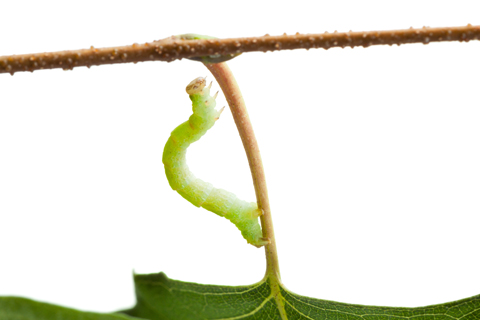
Spring has arrived and with the new season comes new tree problems. It isn’t just the flowers blooming, trees budding, and pollen everywhere; tree pests and diseases are coming alive as well.
Generally, when winter weather and lower temperatures are sustained throughout the season, pests and disease won’t pose much of a threat in the spring. This year however, winter weather and temperatures were relatively mild, favoring the spread of disease and increasing pest population. It’s just the beginning of the season, and there is great potential for tree damage this spring.
The arborist at 72 Tree, Seed & Land Co. identified 5 common tree killers, and methods to get them under control this spring. Also being discussed are routine tree and landscape inspections, pest and disease prevention, and ongoing tree care throughout the year.
3 Common Spring Tree Pests
While there are a wide variety of tree pests, the following have been singled out due to the extent of the damage they can cause. So take heed because, the damage often goes unnoticed until removal of the tree is necessary.
Bagworms – If the leaves on your tree are turning brown or the needles are falling off of your pine, the culprit may be bagworms. Your tree is their food, and as they consume, your tree is unable to produce vital nutrients to keep it healthy and alive.
These worms make a bag-like nest (thus the name) which is often mistaken for a pinecone. In the fall, they mate and each female bagworm is able to lay over 500 eggs that hatch in mid spring.
There are two effective ways of controlling bagworms. You can physically remove and destroy the “bags”, or apply a pesticide in the spring as they are hatching. Once you have confirmed that bagworms have invaded your landscape, you will likely need the help of a professional tree service to keep them under control.
Cankerworms – Also known as inchworms, cankerworms chew away at the foliage of your trees. There are two species of this pest “fall cankerworm” and “spring cankerworm” but don’t let the name mislead you, they both hatch in the spring and feed on the same trees.
The damage they inflict on trees is more stress related and potentially leads to dieback, borer damage, and even root decline. For a healthy tree, one year of cankerworm defoliation won’t necessarily result in the loss of the tree. However, multiple years of defoliation will weaken the tree, making it susceptible to other pests that can ultimately lead it to its death.
When there is a breakout of this pest, there are two principle treatments.
1) Banding the trees in the fall (the wingless females stick to the band and cannot reach the canopy to deposit their eggs) is one very effective measure.
2) The other is the use of pesticides shortly after the worms have hatched. This measure is only effective while the worms are small and should be monitored by an arborist to ensure proper control is achieved.
Southern Pine Beetle – (Dendroctonus frontalis) These boring tree killers are known as the most destructive forest insect in the southern states. The signs or symptoms of an infestation are severe dieback, browning, and eventual death of entire limbs, foliage, and the tree itself.
Once this beetle attacks and succeeds at making a tree its host, the adults emit a pheromone attracting other beetles to the tree. In a matter of days, a tree’s defenses can be overrun by thousands of beetles. As one tree becomes overpopulated, the beetles will seek out nearby trees to colonize, thus expanding their population and local infestation potential.
It is the older and weakened trees that are more susceptible to beetle infestation. Control is accomplished by promoting the health of your trees, and when there is a breakout, applying insecticides to the tree bark is an alternative.
If you have a tree affected or infested by southern pine beetles, you will need an arborist to help identify witch, and if measures can be taken to thwart the infestation.
2 Common Spring Tree Diseases
Throughout the lifecycle of a tree, it may be faced with a number of fungal invaders from its roots to its leaves. While a tree builds a natural resistance to these invaders, trees are not completely immune and can be severely debilitated. The following tree diseases are ones that should be addressed immediately after being diagnosed.
Fire Blight – (Erwinia amylovora) Is a contagious plant disease. Blight is a hard to control pathogen that robs plant and tree foliage of its nutrients, causing the blackening and death of that foliage. Fire blight differs from dieback in that it leaves behind the appearance that the foliage has burned. Thus the name.
Blight is most successful in the springtime, as temperatures and humidity remain ideal for its growth. As with other pathogens, it is spread from host to host by physical contact, insects, birds and other wildlife; be careful when working in the garden because even the tools used for landscape maintenance can transmit fire blight disease.
Moreover, there is no known cure for blight. Control is achieved by pruning and destroying the affected foliage and limbs. The use of pesticides can also aid to control the pest population. As stated, the proper cleaning of equipment after use is helpful to avoid its proliferation. While the planting of resistant or tolerant species is an effective and proactive approach to overcome this disease.
NOTE: When cleaning garden and landscape equipment after handling diseases such as blight, applying a bleach solution (1 part bleach to 4 parts water) to your tools is recommended to neutralize the pathogen.
In the following link we discussed preventing fire blight tree disease in more depth, so check it out for more solutions and detail of this devastating disease.
Heart Rot – Heart rot is a fungal disease causing the softening and decay of the wood found at the center of a tree’s trunk and branches. When you see mushrooms or fungus conks attached to the trunk or branches of a tree, it can be a strong indicator that heart rot is present within the tree.
Fungi enter the tree through damaged bark or poorly pruned ares, move to the heartwood, and begin the process of decay. Softening of the heartwood leaves trees structurally weak and prone to collapse or breakage.
Hardwood trees are affected by heart rot on a global scale, and is extremely difficult to prevent. However, if a tree is growing vigorously, it may be able to isolate the affected portion of itself through a process called compartmentalization.
Control of this destructive disease may be achieved by keeping your tree healthy through proper pruning techniques, annual inspections by an arborist, and post storm maintenance and pruning.
Routine Tree and Landscape Inspections
Tree and landscape inspections start with you. When you’re out mowing, watering, pruning, or playing in your yard, observe the plants, shrubs, and trees. Look for insect infestations, discoloration in the foliage, and dieback of the limbs and crown. For more on dieback and signs of a diseased tree, visit 72tree.com/signs-diseased-tree-dieback-suckers-water-sprouts/
Once a year, hire an arborist to thoroughly inspect your trees and the plant life in your yard. They are trained to spot potential health issues, and implement the best solutions to save and/or extend the lives of your plants.
Prevention and Continued Care
The best preventative maintenance for your trees and plants is the consistent and continued care that you provide them. Healthy plants have the strength to develop defense systems that ward off both pests and disease.
Proper and timely pruning, watering, and fertilizing will help your trees reach maturity faster and in a stronger and more resistant way.
Controlling Pests and Disease All Year
Every pest has its season and every season has its pests. As you have probably gathered by now, the best way to control pests and disease is by keeping your trees, shrubs, and plants healthy through remaining proactive and aware of their state.
Pest control will help in stopping the spread of pathogenic fungi and bacteria, as well as curbing some of the more voracious insects. Fungicides will also help keep many of the pathogens away from your landscape’s ecosystem.
Keep your trees healthy this spring and for years to come by knowing what to look for and which steps to take. And when something strange pops up, call on your local arborist to address and get it solved.
Notice: Undefined variable: page in /home/vrxdg1855sn3/public_html/wp-content/themes/72tree/content.php on line 15
Notice: Trying to get property 'ID' of non-object in /home/vrxdg1855sn3/public_html/wp-content/themes/72tree/content.php on line 15
Tree Pruning Techniques
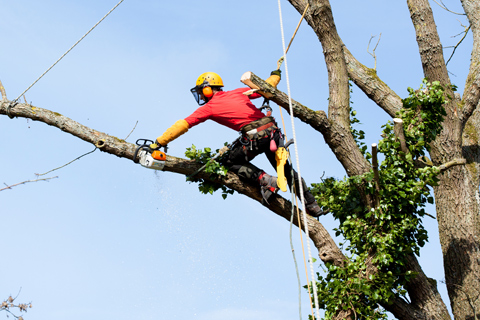
Your trees are constantly responding to environmental changes and throughout the year, they will need some help by way of pruning.
Tree pruning will help to improve the overall health of your trees, their overall appearance, and naturally reduces the possibility of tree failure. The improper pruning of a tree can stress a tree leading to potential decay, infestation, disease, and even death.
Below the arborist at 72 Tree, Seed & Land Co. discuss the different ways trees can be properly pruned.
Tree Height Reduction
When reducing the height of a tree, much care and precision pruning are necessary.
This procedure must be done correctly; “topping” or cutting through the main trunk often leads to several issues for the tree including failure.
Depending on the species and growth pattern of the tree, height reduction may not be possible without irreparably damaging the tree. In these cases, the choice to remove or relocate it may have to be made.
Tree Crown Raising
Crown raising involves the pruning, cutting, or removal of the lowest branches of a tree. This procedure provides more clearance under a tree for people and vehicles.
This procedure, when performed on younger trees, will encourage more growth in the upper branches. When raising the crown on older more developed trees, much caution is needed as the lower branches will be much larger and leave larger wounds.
Tree Crown Thinning
Crown thinning is a wise option for trees that sustain the full force of strong winds or have to bear the weight of accumulated snow or ice.
This is accomplished by the selective and careful removal of branches from within the crown. This process reduces the force of the wind on the canopy, as well as reducing the weight of snow and ice on the tree.
Care must be taken when thinning a crown. The improper procedure or over thinning can lead to disease, decay, infestation, or make the tree more susceptible to being blown over.
Tree Crown Cleaning
As the name suggests, crown cleaning is the removal of dead and dying branches. Crown cleaning is the more common of the pruning options.
This procedure helps to protect your tree by removing unnecessary weight, reduces the risk and hazard of falling branches, helps to halt the progression of decay and disease, thus improving the overall health of the tree.
Small or Ornamental Tree Pruning
Small or ornamental trees should be routinely pruned for many of the same reasons mentioned above. They may also be pruned for simple esthetics or to train them as they grow.
Professional Regular Pruning
Once aware of the signs your tree needs pruning, having your trees regularly pruned by a tree service or certified arborist will keep your trees healthy and beautiful. This will also benefit your landscape by the early detection of problematic infestations, fungi, or irregularities that may otherwise go unnoticed until it’s too late to correct.
An added benefit to regular pruning services is curb appeal. The better your landscape appears, the more curb appeal your property will have. This usually translates to a higher property value.
Overall, pruning is beneficial and necessary throughout the year. Follow these tree pruning tips, and visit our tree care blog more articles and information.
Notice: Undefined variable: page in /home/vrxdg1855sn3/public_html/wp-content/themes/72tree/content.php on line 15
Notice: Trying to get property 'ID' of non-object in /home/vrxdg1855sn3/public_html/wp-content/themes/72tree/content.php on line 15
What Is an ISA Certified Arborist?
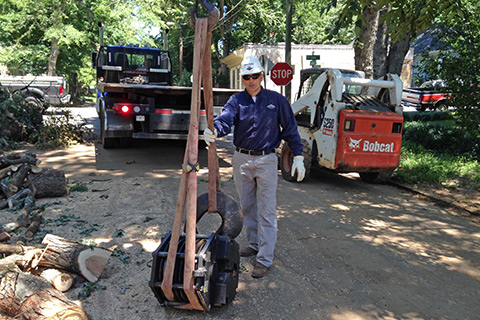
If you have trees in your landscape, you should already know the immense value they can bring to your property. More-so, you should be aware of the danger they may pose if left uncared for. Keeping your trees healthy, well pruned, and vibrant works to create a diverse landscape ecosystem while boosting your home’s curb appeal.
The Role of an Arborist in Your Tree Care
When in the planning stages or the implementation phase of your landscape, consulting an ISA Certified Arborist will keep you from making potentially costly mistakes. Some trees should never be planted near structures, while others (with invasive root systems) should not be located near water supply lines, driveways or asphalt.
As your landscape grows and ages, the role of a Certified Arborist is to help you maintain your trees properly pruned, trimmed, and more importantly – healthy. When those trees are compromised by disease, pest infestations or severe weather, it is a properly trained and equipped arborist who can determine the best course for its removal.
Watch how our Roswell Ga arborist (https://georgiaarborist.org/Sys/PublicProfile/246617/62524) coordinates the removal of a high-risk tree using a 275 ton crane:
What is an Arborist?
Simply put, an arborist is a tree care professional. They are trained and have invested significant time in the study of planting, caring for, treating, removing, and overall maintenance of trees, either individually or in an ecosystem.
What is an ISA Certified Arborist?
For nearly a century, the International Society of Arboriculture (ISA) has been a fundamental part in both the science and education within the tree care industry.
To become an ISA Certified Arborist, an individual must reach a level of knowledge and practice in the art and science of tree care. To carry the title “certified”, a comprehensive exam (created and developed by leading tree care experts) must be passed. It cannot go without mentioning that this process and certification are completely voluntary.
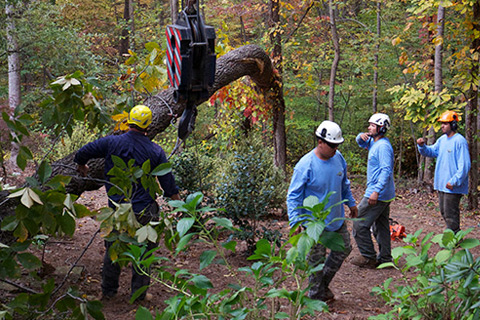
It doesn’t stop there. In order to maintain certification, Certified Arborists must follow a strict code of ethics and continue their education. Due to this aspect alone, when you call on a Certified Arborist, more-than-likely, the individual will possess the most current knowledge and practice available in the tree care industry.
NOTE: ISA Certification can attest to the knowledge of a tree care professional. It does not measure the standards nor the quality of service or performance.
The Hiring of a Tree Care Professional
All ethical Certified Arborists will agree that the decision to hire a tree professional should not be taken lightly. It is important to do the research and “know” who you are contracting to manage your tree issues. All ISA certified arborist are listed here: http://www.treesaregood.org/findanarborist/findanarborist
Look for reviews, ask for references, check out current or past projects to see (first hand) the quality of their work. It cannot be overstated, the necessity to be comfortable with the services provided by your tree professional, as that relationship may be ongoing for many years.
72tree.com staffs a master arborist to help Roswell residents with tree removal, cutting, disease, or assessment services. We look forward to assisting you and preserving the health of your trees and plants.
Notice: Undefined variable: page in /home/vrxdg1855sn3/public_html/wp-content/themes/72tree/content.php on line 15
Notice: Trying to get property 'ID' of non-object in /home/vrxdg1855sn3/public_html/wp-content/themes/72tree/content.php on line 15
Preventing Fire Blight Tree Disease
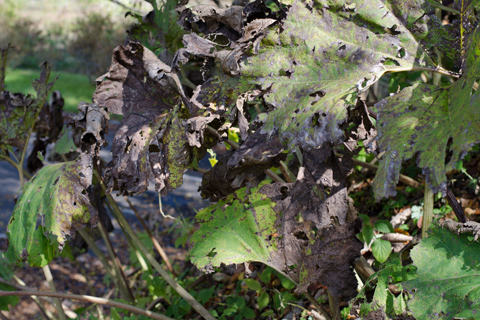
What is Fire Blight Tree Disease?
Fire blight is a hard to control disease of fruit trees like pear and apple. It is caused by bacteria, its effects are devastating and it leaves a behind a burnt appearance; this is where it gets its name from. In addition to fruit trees, it attacks ornamental plants like roses, cotoneaster crabapple, loquat, hawthorn, pyracantha, and mountain ash. Unlike dieback, fire blight attacks flowers first, twigs next and finally branches.
Signs of this Disease
The first signs of fire blight usually appear in early spring, when the weather is humid and rainy and when temperatures rise above sixty degrees. Flowers infected by the disease turn black and die. The disease moves through the branch, infecting and killing young twigs. These dead twigs go black and curl over like a shepherd’s hook.” Affected branches look fire scorched as their leaves are black and wilted. Cankers, which are slightly sunken areas show up on the branches and the trunk. Fire blight affects many parts of the plant including leaves, stems, fruits and blossoms. In wet spring weather, a translucent milk-like, sticky liquid that contains multitudes of bacteria oozes out of the infected part of plant.
Fire blight spreads effortlessly in a lot of different ways and through different means, they include:
• Insects, birds, and animals transmit it from one plant to another.
• Rain drops splashes the bacteria among plants.
• Plants make contact all the time, that way the bacteria can move from an infected plant to an uninfected plant.
• Gardening tools can transmit the disease when gardening or even when watering. Tools should be sterilized after use on an infected plant.
Late spring or early summer is the maximum time of risk of infection. At this time, the bacterial emerges from its dormant period and the cankers become more pronounced. Infected branches should never be left on the ground when pruned, they should be immediately burnt or put in a bin as placing them on the ground could infect the surrounding bushes or trees.
Commonly Affected Plants
In your home garden, fire blight can be very damaging to pear and apple trees especially pear trees as they are very susceptible. Some pear trees, (e.g. Bradford) are unaffected by the disease but can develop it when the environment is advantageous to disease development. Some plants in the rose family such as the Rosacea, can be infected with fire blight, others include; mountain ash, photinia, crabapple, hawthorn, loquat, pyracantha, spirea, cotoneaster and quince.
Prevention & Treatment
Fire blight has no cure thereby making prevention very important. Though there are many ways to control fire blight, these methods are not 100% effective. Some fire blight control methods include; making use of recommended sanitation measures and cultural practices, choosing tolerant varieties, and applying bactericides and insecticides.
Bactericides & Insecticides: Bacteria enters plants through fresh wounds, blossoms or natural openings, it is then spread by rain and insects such as ants, bees, aphids, beetles and flies who transfer the bacteria to blossoms. Insect control can decrease the spread of bacteria, however, insecticides shouldn’t be used when plants are blooming. To learn more about disease and pest prevention oils, visit: 72tree.com/using-dormant-horticultural-oil-treat-tree-insect-infestations/
Sanitation Measures & Cultural Practices: all infected plant parts should be removed and destroyed, and all pruning tools should be disinfected with household bleach and water (one part bleach and nine parts water). This will lead to a reduction in the spread of the disease. Cuts should be made at least 8 to 12 inches beneath the infected tissue.
Pears: Pear trees can be treated with a copper fungicide spray (pre-bloom) and a streptomycin spray in bloom. The first spray should be applied immediately the flowers open and should be repeated every three to four days. There should be a minimum of fifty days between the application of streptomycin and harvesting of fruits.
Apples: If fire blight was severe the year before, then copper fungicide should be sprayed just before bloom. All branches and spurs should be thoroughly covered with streptomycin spray which is the recommended bactericide for apple trees in bloom. It should be sprayed first at the beginning of bloom and should be repeated every three to four daysas long as there are flowers.
Crabapple: copper fungicides are also used to treat crabapple trees. In other to lessen bacterial inoculum on the exterior of twigs and spurs, they should be applied before and after bloom. It shouldn’t be applied when plants are blooming as it may cause fruit abortion or russeting on the plant.
Arborists Discuss Controlling Tree Disease
Scheduling an annual inspection of your landscape is another way to prevent and treat tree disease. When you detect that something has gone awry with your trees and plants, contact your local tree professional. Properly identifying and treating the issue is key to halting it and preventing future occurrences.
Sources:
http://www.clemson.edu/extension/hgic/pests/plant_pests/veg_fruit/hgic2208.html
https://www.extension.purdue.edu/extmedia/BP/BP-30-W.pdf
Notice: Undefined variable: page in /home/vrxdg1855sn3/public_html/wp-content/themes/72tree/content.php on line 15
Notice: Trying to get property 'ID' of non-object in /home/vrxdg1855sn3/public_html/wp-content/themes/72tree/content.php on line 15
Signs of a Diseased Tree – Dieback, Tree Suckers & Water Sprouts
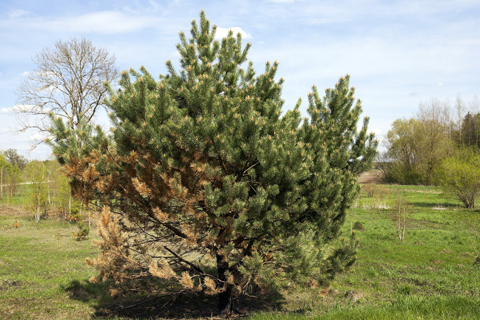 Spruce with dieback needs tree care to preserve healthy landscape.
Spruce with dieback needs tree care to preserve healthy landscape.
Many diverse diseases affect your landscape, shrubs and trees. Identifying these diseases is critical because, not all tree diseases can be controlled. We love to watch things grow when we garden but we must note that not all growth is positive or advantageous to the trees. Some of these growths take energy away from the tree; common examples include water sprouts and suckers. At 72tree.com we often see the damaging effects of tree disease, and in this article, dieback, tree suckers and water sprouts are the disorders we’ll be discussing.
Dieback of a Tree or Its Limbs
In spring as the weather gets warmer, and buds start noticeably leafing out, you might notice that a section or even an entire limb is not leafing out consistent with the rest of the tree. Dieback is a condition in which the ends of the tree branches die. These sections are generally located at the limb tips, but can also be entire limbs or sections of the tree where there will be no leaves. Most times, this is a sign that all is not right with the tree.
Water Sprouts Due to Branch Removal
Water sprouts are dynamic shoots that develop from dormant buds either on large branches or trunks of a tree. They are usually upright and in many cases occur as a result of the removal or trimming of large branches. Heavy pruning may also lead to the production of more sprouts. Tree stress may also result in water sprout growth, but it’s not usually as vibrant as those that occur due to pruning.
Trees should be checked regularly. If you notice new shoots, eliminate them by rubbing them off as they emerge. Large water sprouts can be pruned off close to the trees trunk. Water sprouts can ruin a tree’s shape and they also divert the tree’s energy by blocking air circulation and light. Though not advised, some allow sprouts to grow in the place of missing branches, but it may lead to a reduction in quality of the tree’s ability to bear more fruits. Also, water sprouts are more inclined to promote tears, disease and breaks, as they are generally weaker than other branches.
Tree Suckers
Suckers are un-planned, vegetative growths that stem from a tree’s root system. Suckers grow from rootstock and divert nutrients away from the trees top growth. There isn’t any actual benefit from letting suckers grow because, rootstocks are usually different from the type of tree that you planted (example – a Gala apple tree will not have a Gala apple rootstock).
To find and cut from the base of a sucker, you may have to pull back any ground cover and dig up some soil to fully expose the sucker. Ensure that as much growth as possible is removed to reduce the potential of them popping up again. If they do re-emerge, this simple process will have to be repeated. Although suckers and water sprouts are similar, remember suckers originate from the root or base of the tree.
Tree Disease Prevention and Care
You might be able to deal with a disease that occurs on your trees and shrubs but you ought to consider consulting a local arborist or tree service professional if you are uncertain. The arborist will identify any disease and offer you the best treatment options and the ideal time to care for the tree.
Early spring (during most maintenance pruning) is the best time to remove both water sprouts and tree suckers. However, these unwanted growths sometimes sprout and occur during the growing season, they should be removed as soon as you notice their existence. Your trees will thank you and be fruitful!
